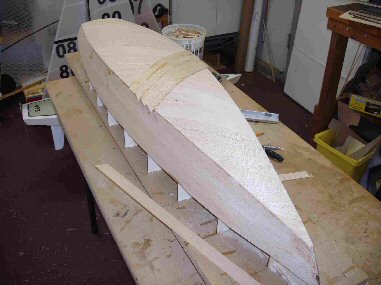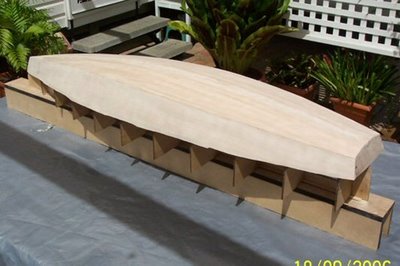Just before leaving on our recent road trip (4,500km), I wrote a post about a planing hull version of my popular
Flint design. I was quite excited about the concept of a planing skiff for low-powered outboard, having had it in the back of my mind for a very long time.
With this latest design, (see here for details in the previous post), I had to produce the basic drawings in a very short space of time (about three days), as we were about to leave on what turned out to be more than four weeks of road travel. Having given thought to such a design in the past, I felt that I could get enough detail out to satisfy the owner/builder, who is an exceptionally capable person with high-level engineering qualifications.
 |
| Stitching-up Flint on which the new design is based |
 |
| Here you can see the complex shapes which can be formed in plywood, as long as the panel shapes are "developable". |
In order to produce a design which can be built stitch-and-glue from pre-computed plywood panels, one has to resort to relatively complex geometrical drawing. In the past, the drafting methods used to develop the panels tended to result in hulls which were full up forard and had straight buttock lines aft. The hulls so drawn are frequently apple-cheeked at the bow and lack displacement aft - not a good shape.
With the availability of complex hull modelling software, it is quite practical these days to engage in the design of developable hulls which were never possible in the past because of the unbelievable volume of calculation required in manual drafting. I am not a computer person, but I love my hull modelling and CAD software!
In my extreme rush to get drawings to the builder before leaving on our trip, I burnt the midnight oil fairing-up the hull shape on the computer, and when all was satisfactory, I hit the button to produce the panel developments.
 |
| Panel developments for one of my other designs |
Off I went on four weeks of road travel, confident that the information provided would be adequate for my talented customer. The trouble is that in my confident state-of-mind I had neglected to test the developments as I usually do, using a scale model.
 |
| Scale model panel developments for Three Brothers, cut from 1/16" plywood |
 |
| Testing panel developments at small scale |
On the day of my return from the first of two long road trips conducted over the last four weeks, I received an email from my customer to say that he had cut all the panels for the planing hull version of of
Flint (named
Fleet) using his own CNC equipment (!), and that he was having problems with the initial stitching process. He was of the opinion that
he was doing something wrong, having never built a stitch-and-glue boat, but I had a more sinister suspicion!
For a long time, Ive had a feeling that some hull modelling programs have a hard time doing developments which incorporate large amounts of twist and bend at the same time. When one considers the unbelievable number of calculations required, and the geometrical complication, it is little wonder. In order to test my supposition, I reverse-engineered the offsets of
Fleet into Gregg Carlsons "Hull Designer" program, which had proven itself to be very accurate at this sort of job in the past.
I generated a set of developments using the Carlson Hull Designer, and superimposed them over the ones I had generated from the other program. In the illustration below, you can see the Carlson developments in red, overlying the others in a dark colour. The topside panels are virtually identical, but the bottom panels show substantial difference.
 |
| Fleet developments showing the originals in black, and the Carlson Hull Designer developments in red. |
As you can see, there was enough difference between the two different bottom panel developments to produce serious problems. So, my customer had not caused the problem - it was caused by my over-confidence, haste, and lack of testing! Below are some photos showing the result...
 |
| Bottom panel having failed in tension at the keel-line near the first frame (near the bow) |
 |
| View of the failure from the inside. See how the crack has initiated at the keel line, and extended upwards and outwards from the keel line. |
Having wiped the egg from my face, and being confident that the new developments would solve the problem in subsequent boats (but I will be doing tests this time!), the problem remained about how to fix the first boat without having to scrap the entire pair of bottom panels. The suggestion I made was along the lines of, "if you cant beat them, join them". I recommended to the customer (luckily for me he is a very clever and resourseful chap) that he use a saw to cut a whole series of of similar "failures" across the keel line both forward and aft of the initial failure, so that the topside panels could pull the incorrectly shaped bottom panels into the proper position. This was done, and with each successive cut the original failure closed up a little more, and an even bend formed in the keel line.
 |
| Here you can see some of the deliberately cut lines, filled with thickened epoxy and finished off with a "stop drill" at the upper end.The dark line closest to the camera is a scarph joint, but you can see the artificial "failure" cuts filled with white thickened epoxy forward of the scarph. |
 |
| Glass tapes dry-fitted, with some extra tapes to reinforce the new cuts |
 |
| A wider view, showing how the repair has restored the boat to a nice, fair shape. |
There are a number of lessons from this project: -
- I should not assume that drawings for a new design are correct without testing them;
- Never give up, because just about anything can be fixed if you do some careful thinking;
- Dont take what I say too seriously, as Ive proved myself to be wrong on frequent occasions!!!
Boat building and designing is a lot of fun, and I really look forward to seeing how this particular boat turns out. I believe that there is a genuine need for an outboard-powered skiff which can perform well with a low-powered motor - say 4hp - and still be spirited and lively.














































 OR:
OR:





